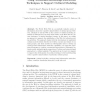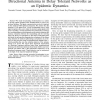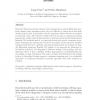60 search results - page 6 / 12 » Bio-PEPA for Epidemiological Models |
SBP
2011
Springer
13 years 2 months ago
2011
Springer
The World Wide Web is a potentially valuable source of information about the cognitive characteristics of cultural groups. However, attempts to use the Web in the context of cultur...
JSAC
2010
13 years 6 months ago
2010
—We study broadcasting of information in a system of moving agents equipped with omnidirectional as well as directional antenna. The agent communication protocol is inspired by t...
WIOPT
2010
IEEE
13 years 6 months ago
2010
IEEE
— By analyzing people’s contact patterns over time, it is possible to build efficient delay tolerant networking (DTN) algorithms and derive important data for parameterizing an...
WSC
2007
13 years 10 months ago
2007
Agent-based models (ABMs) are powerful in describing structured epidemiological processes involving human behavior and local interaction. The joint behavior of the agents can be v...
AIME
2003
Springer
14 years 1 months ago
2003
Springer
Objective: Deep biomedical models are often expressed by means of differential equations. Despite their expressive power, they are difficult to reason about and make decisions, g...



